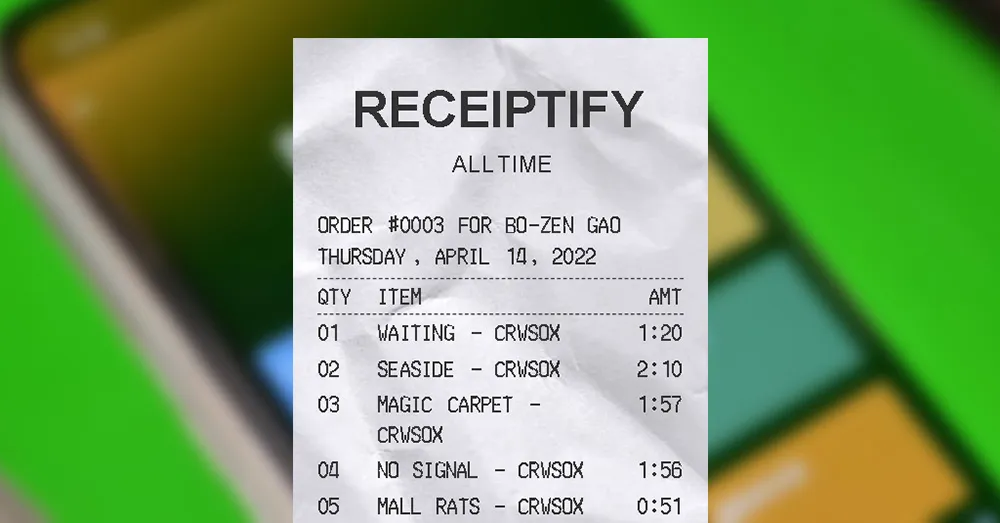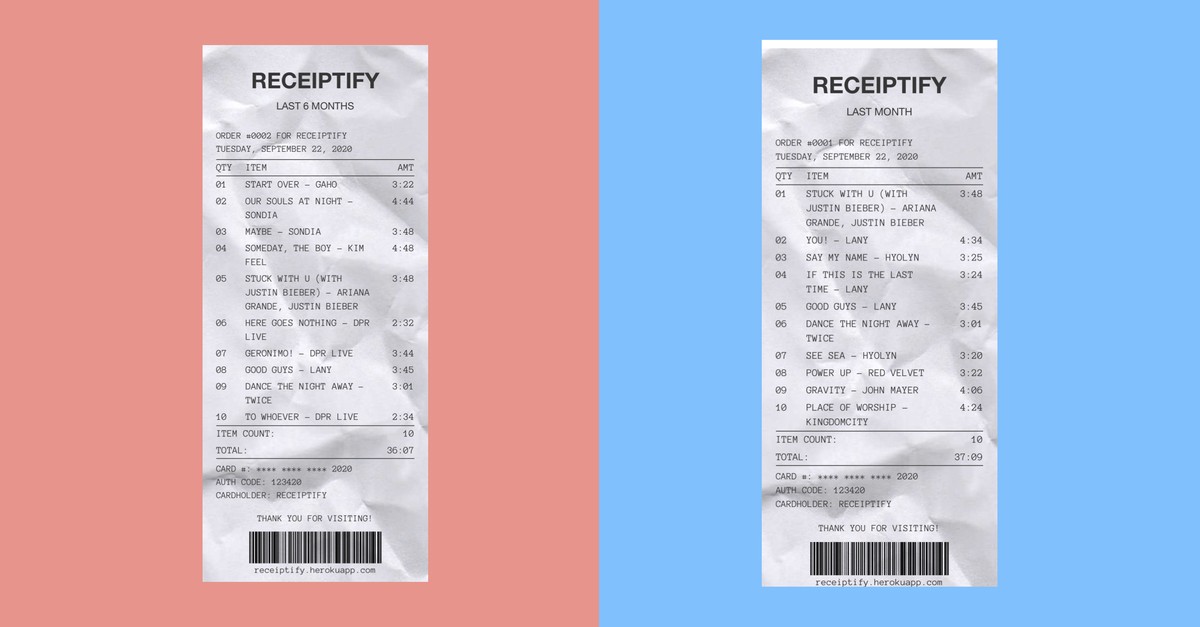In the world of music streaming, end-of-year listening recaps have become popular ways for platforms like Spotify and Apple Music to showcase users’ top artists, albums, and tracks. Spotify Wrapped and Apple Music Replay both provide visually appealing snapshots of annual music statistics. But what about viewing your listening trends over shorter timeframes? That’s where handy third-party tools like Receiptify come in.
Receiptify is a web app that generates receipt-style graphics displaying your top tracks from Spotify, and Last. fm, and Apple Music profiles. For Apple Music users, it provides an easy way to visualize your all-time most-played tunes outside of the Apple ecosystem. However, limitations in Apple’s backend data capabilities mean the overall user experience isn’t quite as robust as other platforms.
But when used properly, Receiptify can still offer Apple Music subscribers quick insights into their listening habits over time. If you encounter any issues getting your Apple Music receipt to generate properly, this guide provides troubleshooting tips and advice for optimizing Receiptify. Let’s explore how Apple Music integration works and how to use Receiptify receipts to rediscover your musical past.
Getting Started with Receiptify for Apple Music
First, head to Receiptify’s website on your iPhone, iPad, or computer browser. You’ll see large buttons prompting you to log in via Spotify, Last. fm, or Apple Music. Click the Apple Music option and enter your Apple ID credentials when prompted.
The login process enables Receiptify to securely access your Apple Music profile and listening history data. You may need to complete two-factor authentication or tap “Allow” on an authorization pop-up.

Once connected to your account, Receiptify will process your playback information and generate a visualization of your all-time top 10 Apple Music tracks. This includes details like song titles, artists, album covers, and total play count. It’s an easy way to get a snapshot of your long-term listening trends.
Save or Share Your Listening Receipt
Underneath the receipt graphic, you’ll see options to either “Download Image” or “Create Playlist.” Saving the shareable image is a great way to post your listening trends on social media or messaging apps. You can also use the raw data to create Apple Music playlists based on your top songs and rediscover forgotten favorites.
Apple Music Receiptify receipts make it simple to give friends and followers a taste of your listening history. The shareable graphics are perfect for connecting over music and reminiscing about favorite tunes.
Why Apple Music Receiptify is Limited to All-Time Stats
While Receiptify supports visualizing Spotify and Last. fm data over custom timeframes, Apple Music integration is currently limited. The reason comes down to differences in how Spotify and Apple expose listening statistics via their development APIs.
Spotify provides more granular access to a user’s historical playback data. So Receiptify can showcase your top Spotify tracks over the past month, 6 months, 1 year, or all-time.
Apple Music’s API capabilities are more restricted, only supplying a generalized “Heavy Rotation” playlist. So Apple Music receipts will only display your top tracks of all time rather than specific periods.
Until Apple provides expanded access to its listening data, Receiptify is stuck showing all-time Apple Music statistics. But this can still provide helpful high-level insights into your heaviest music rotations.
Troubleshooting Receiptify for Apple Music
- Enabling pop-ups: The login process relies on pop-up windows, so ensure they’re allowed in your browser settings.
- Refreshing the site: Heavy traffic can sometimes disrupt the site, so try refreshing and reloading your Apple Music profile.
- Clearing cookies/data: Remove any corrupted Receiptify site data cached on your device and try reconnecting your account.
- Switching devices: Testing Receiptify on another smartphone or computer may resolve any device-specific errors.
- Contacting support: For persistent account or site errors, you can reach out to Receiptify’s customer support team directly.
Because seamless functionality hinges on API access, you may encounter issues generating or sharing your Apple Music receipt:
With the proper troubleshooting, you can get Receiptify working smoothly again and generating Apple Music listening recaps. The developers are continually working to enhance cross-platform support and optimize stability.
Using Your Data to Expand Apple Music Libraries
In addition to sharing your top tunes, you can use Receiptify insights to build out your Apple Music profile. Browse through your all-time tracks and re-add any favorites you want to start listening to again. Or explore albums and artists related to your top songs and enrich your music library.
Over time, review your historical Receiptify charts and consistently add nostalgic tracks back into rotation. Turn Receiptify data into active Apple Music playlist building and music rediscovery.
Creative Ways to Share Your Listening Receipt
Part of Receiptify’s appeal is transforming your listening stats into shareable content. While Apple Music integration is limited to all-time data, there are still creative ways to get social with your music tastes:
- Post your receipt on social media straight from the site using the “Download Image” tool.
- Edit your image further in apps like Canva to make it pop before sharing.
- Share songs directly from the associated albums and artists using the iOS or MacOS music-sharing menus.
- Screen record scrolling through your top tracks to give followers a taste of your classics.
- Go live on social platforms like Instagram and have fans guess the artists as you play song clips.
Get clever repurposing your all-time Apple Music data into engaging social content – Receiptify makes it easily accessible.
Alternative Ways to Share Apple Music Listening Stats
In addition to Receiptify, there are a couple other options for showcasing your Apple Music statistics:
Apple Music Replay – Apple’s officialWrapped alternative showing your top annual artists, albums, and tracks.

Instafest – Creates Coachella-style festival posters featuring your top Apple Music artists. Seamlessly syncs with your library.
These tools help add diversity to how you visualize and share listening trends. But Receiptify remains the quickest option for receipt-inspired snapshots of your Apple Music activity.
Take Your Music Listening Insights Further with Smarter Software
While Apple Music’s API limitations restrict the breadth of data accessible, there are other software solutions music lovers can use to get richer insights into listening habits across platforms:
Last. fm – One of the original music profiling sites, Last. fm captures comprehensive listening statistics by connecting to music apps and services. Integrates directly with Receiptify.
MusicHarbor – An app that tracks new releases from your favorite Apple Music artists. Helps you stay on top of new music from your top charts.
Soundiiz – Enables transferring playlists and library data between platforms like Apple Music, Spotify, YouTube, and more. Achieve unified listening profiles.
These tools demonstrate the wider potential for maximizing music listening experiences when companies open up access to data.
The Next Era of Music Listening Analytics
As streaming becomes the dominant form of music consumption, brands like Spotify and Apple recognize the value of providing users with playback statistics and listening recaps. However relying solely on first-party ecosystems limits the potential creativity in music data visualization.
That’s where third parties like Receiptify come in – offering new interactive angles for engaging with your listening history across platforms. Enabling universal access to music statistics via APIs fosters innovation and better servicing of power music users.
The future lies in putting users at the center of the music data experience. Their listening activity translates into a myriad of new applications when opened up, rather than contained. Receiptify represents just one example of fresh approaches to music discovery and nostalgia that become possible when your listening behavior data is portable.
FAQs About Using Receiptify with Apple Music
Does Receiptify work on iPhones?
Yes, the Receiptify website is mobile-optimized to work great on iPhones and Android smartphones. Just head to the site on your device’s browser.
Can I get my Apple Music listening stats for the last month only?
Unfortunately, no. Due to Apple’s API limitations, Receiptify can currently only generate all-time top listening data for Apple Music profiles.
Is my Apple Music data safe when using Receiptify?
Absolutely. Receiptify has strong data privacy policies in place and does not share any user listening information elsewhere.
Why does Receiptify fail to work sometimes with Apple Music?
Issues generally arise from pop-up blockers, corrupted browser data, or heavy traffic. Refer to the troubleshooting tips in this guide to resolve common errors.
Are there any Apple Music alternatives to Receiptify?
Apple’s own Apple Music Replay provides annual listening recaps. Instafest creates shareable artist festival posters. But Receiptify remains the best for receipt-style top tracks visualization.
Take Your Music Listening Insights to the Next Level with Receiptify
Receiptify makes it easy for Apple Music users to get a snapshot of their all-time most played tracks in a neatly packaged graphic. While limited by Apple’s API capabilities, it can still provide helpful nostalgic listening insights when troubleshooting errors.
Optimized sharing on social media and playlists built off your top tunes are just a couple of ways to engage more with your Apple Music profile thanks to Receiptify. Discover new angles on your listening stats and take your music rediscovery to the next level.

1 thought on “How Receptify Apple Music Login, Unlocking the Beat: Receptify Apple Music Login Guide”